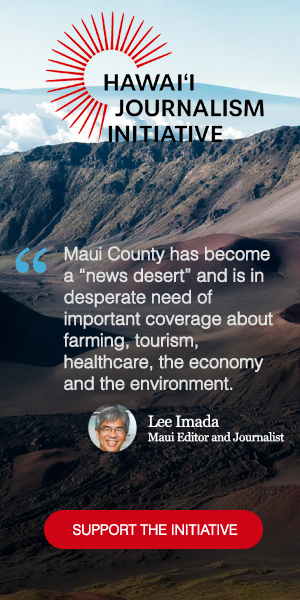 Hawai‘i Journalism Initiative
Hawai‘i Journalism InitiativeWhat happens when highway moves mauka? University of Hawaiʻi, nonprofit hope to restore 6-mile stretch of West Maui shoreline

When Tamara Farnsworth stood along the Manawaipueo Trail, also known as the Lahaina Pali Trail, and peered toward Olowalu on a recent morning, she saw a reef and shoreline in need of protection.
Despite constant traffic in both directions on Honoapiʻilani Highway below, she envisioned what the area could look like once again, with kalo fields, coconut farms and natural living buffers to protect the shore from the rising seas. She imagined a greenway for pedestrians and bikers, with more peaceful shorelines to be used by fishermen, surfers, snorkelers and families.
HJI Weekly Newsletter
Get more stories like these delivered straight to your inbox. Sign up for the Hawai‘i Journalism Initiative's weekly newsletter:
It’s a dream that can come true, with a 6-mile stretch of the highway from Ukumehame to Olowalu expected to be moved inland as part of the state’s upcoming $90 million Honoapi’ilani Highway realignment project to deal with climate change.
Farnsworth is a project manager of an 18-month study called “Olowalu: The Road to Resilience,” which will figure out — with plenty of public engagement — what should be done with the area. It is being conducted by a joint effort of The Nature Conservancy and the University of Hawai’i’s Community Design Center.
After four years of preliminary work, the project officially began in November and now is available to view online, with three community engagement meetings scheduled. The first public meeting is on Jan. 30 at the Lahaina Intermediate School cafeteria, and will include a free light dinner.
“We really want to just provide as much opportunity for people to give their input every time,” said Farnsworth, The Nature Conservancy’s coastal resilience project manager for the Maui Marine Program.
The project features several goals, but they all start with protection of the Olowalu-Ukumehame reef system and the shoreline, Farnsworth said.
“We want to take a look at how do we make sure that we’re holding on to as much of the shore as we can,” she said. “This place doesn’t have traditional dunes like in other places. … This is mostly rocky shores or cliff lines. We want to look at how to protect them, like using nature-based solutions.”

Plans to realign Honoapi’ilani Highway are slowly coming to fruition. A draft environmental impact study for the project was released last week and offers four different routes to relocate the roadway away from the ocean that has been eroding it in several places from mile markers 11 to 17.
“Over the past 10 years, Honoapiʻilani Highway has been repaired three times after storm and high-wave events undermined pavement sections and overtopped the highway, making the roadway impassable,” the draft report said. “These projects are short-term fixes because they address only the most severe locations where Honoapiʻilani Highway is already undermined. The need for the project is directly tied with climate change and sea level rise and the harm it is already causing to the existing highway.”
If the roadway is realigned, the Hawai’i Department of Transportation would seek to transfer the old road to Maui County and road access would be provided for existing homes, businesses and pedestrians. Maui County will then decide how the roadway will support planning and policies, the draft said.
The study is one of the early steps required for the project, which is expected to begin construction in fall 2027, according to the project’s website.
The Nature Conservancy and the UH Community Design Center partnership is planning to work with the county, state Department of Transportation and Federal Highway Administration to shore up the area as Honoapiʻilani Highway is relocated.
The “Olowalu: Road to Resilience” engagement website says the realignment project provides a unique opportunity to re-envision the old right-of-way and restore the area’s coastal zone by incorporating park spaces, traditional bio-cultural practices and nature-based solutions, such as living shoreline systems.
“By strengthening coastal ecosystems, this project intends to increase the ecological, social, cultural, recreational, and economic benefits they provide and reduce pressures on the Olowalu-Ukumehame reef system,” the website said. “The work aims to improve coastal and community resilience to help mitigate and adapt to the growing impacts of climate change, including sea level rise.”
The Olowalu Reef is the most important reef system in Maui Nui, Farnsworth said. It is a vast 1,000-acre ancient coral expanse that is home to the largest known manta ray population in the United States and the oldest coral in the main Hawaiian Islands. In 2017, it was named a Mission Blue Hope Spot for its rich diversity of marine life.
“The reef acts as a nursery to replenish and populate the reefs of Maui, Molokaʻi and Lānaʻi,” Farnsworth said. “We must ensure that this Olowalu Reef is protected so that we protect the entire reef systems of Maui Nui.”
Nearby resident Christian Balagso helps run his family pig and chicken farm, called LB Farm after the initials of his maternal grandparents Lawrence and Becky Cabanilla. It is a 2-acre plot about a quarter-mile mauka of mile marker 15 in the middle of the project area. Balagso, the head coach of the Lahainaluna High School wrestling teams, also lives on the property with his wife Ivy Navarro Balagso, his mother and father and his brother’s family of three.
“I’m no expert in reef conservation or anything like that, but I do know the road does get wet when the surf or the tide’s up, so that’s clearly an issue that needs to be addressed and I’m sure that’s why they’re pushing for the highway to be moved,” Balagso said Thursday. “Anything that does happen, I’m sure there’s a lot of cultural and historic areas in that area, so it’s going to have all those extra permitting steps. You have got to be really careful with what they do out there no matter what they decide to do.”
Farnsworth said public input at the meetings is important to the success of their project.
“What can you envision? What would you like from this area? Do you want more recreational opportunities? Do you want to see bio-cultural practices such as raising kalo (taro) or raising coconut? You know, this whole place used to be completely terraced out growing kalo, new coconut,” Farnsworth said.
“So do people want to see more opportunities for that kind of farming again, people coming back and practicing their traditional ways? Do they want to see us working to protect the shoreline as much as possible, shoring it up using nature-based solutions to maybe create a living shoreline … where we plant things to hold some of the shoreline in place as long as we can?”

Restoring the wetlands in the area also is a key part of the effort, because not only do they have inherent value but they also can mitigate natural threats and hazards such as coastal flooding and sedimentation, she said.
The project also recognizes that this stretch is a “very amazing, historical place,” Farnsworth said. “It’s known to most as the Pali Trailhead. But it’s also the termination of the Ala Loa (long trail), which was known as the King’s Trail. And that went from all the way from Wailuku.”
The public meetings for the project begin with the in-person event from 5:30 to 7:30 p.m. at the Lahaina Intermediate School cafeteria on Jan. 30, followed by virtual meetings on Feb. 11 from noon to 1:30 p.m. and Feb. 13 from 5:30 to 7 p.m. They are part of the research, analysis and engagement phase of the project that began in November and runs through February.
Both Balagso and Farnsworth noted that there are encampments in the area that will be affected by the proposals.
“I’ve seen a few that are obviously houseless who have spent the night over there in their cars and whatnot,” Balagso said. “It’s only a problem if they come and they trash the place.”
Balagso said that getting the decision-making process and final outcome right is imperative.
“To get it right? Very, very important, I think that’s the most important thing because I believe we’ve only got one shot at it, right?” Balagso said. “So, we don’t want a disaster like the Honolulu railway, where they planned something and then it doesn’t work and halfway through they’re trying to change it and running into all these problems. So, it’s a project that never gets done. We’d have pieces of highway scattered throughout so the land is not even usable. So, very important to get it right.”
The university’s Community Design Center is a service-learning program and teaching practice, established and led by the School of Architecture. It provides a platform for applied research, planning, placemaking and design involving UH faculty, staff, students and partnered professionals across UH campuses, departments and professional disciplines.
Judith Stilgenbauer, a Fellow of the American Society of Landscape Architects, is the principal investigator and a professor in the school of architecture. She heads a team of six made up of two research assistants and four students working on the project.
“When we start projects, typically the first set of meetings is really to inform stakeholders in the public of the project, routine, what we do, that it is in the public interest, we are not doing it for a profit, just to set the tone,” Stilgenbauer said Tuesday.
“Then we go through a series of interactive exercises where we ask relatively simple questions regarding community concerns, preferences, input, just an opportunity for folks to talk story and for us to hear them.”
But as a design organization, Stilgenbauer said they will also come with “maps or informational presentations or models” to better engage participants who may also be visual thinkers.
The second of the project’s four parts will run from March to June to include an evaluation of the overall existing conditions of the area, an initial proof of the project design, identification of catalytic sites, initial draft designs for the catalytic sites and the initial community feedback.

The third part will run from July to December and include proof-of-concept design revisions and final proof-of-concept design for the overall project site.
The final phase of the project, from January to May in 2026, includes plan revisions as needed, a cost estimate and the final project report.
Public hearings will also be held to allow comment on plans to move Honoapi’ilani Highway mauka. The first is Jan. 23 at the Lahainaluna High School cafeteria from 5-8 p.m.; the second is virtual on Jan. 28 from 5-8 p.m. There will be a 45-day public comment period through Feb. 24.





